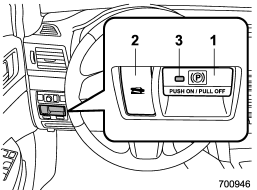Subaru Outback (BR): Electronic parking brake

1) Parking brake switch
2) Hill Holder switch
3) Indicator light
WARNING
● Before exiting the vehicle, make sure that you turn off the engine. Otherwise, the parking brake may be released and an accident may occur.
● If the brake system warning light flashes, the electronic parking brake system may be malfunctioning. Immediately stop your vehicle in a safe location, use tire stops under the tires to prevent the vehicle from moving and contact your SUBARU dealer.
CAUTION
● When the electronic parking brake system has a malfunction and the parking brake cannot be applied, contact your SUBARU dealer immediately for an inspection. If you have to park your vehicle in such conditions, perform the following procedure.
– Stop your vehicle in a flat location.
– Shift the shift lever in the “1” or reverse position (MT models).
– Shift the select lever in the “P” position (AT or CVT models). When the select lever cannot be shifted into the “P” position, you must release shift lock. Refer to “Shift lock function” F7-20.
– Use tire stops under the tires to prevent the vehicle from moving.
● Never drive while the parking brake is applied because this will cause unnecessary wear on the brake linings. Before starting to drive, always make sure that the parking brake has been released and the brake system warning light has turned off.
Your vehicle is equipped with an electronic parking brake. You can apply/release the parking brake by operating the parking brake switch.
To apply: Depress the brake pedal and press the parking brake switch firmly. To release: Pull the parking brake switch toward you while the ignition switch is in the “ON” position and the brake pedal (all models) and the clutch pedal (MT models) are depressed.
When the parking brake is applied while the ignition switch is in the “ON” position, the brake system warning light and the indicator light on the parking brake switch illuminate. Refer to “Brake system warning light” F3-17.
NOTE
● If the parking brake switch is pulled with the ignition switch in the “Acc” or “LOCK” position, the parking brake is not released.
● If the parking brake switch is pulled without depressing the brake pedal or the clutch pedal, the parking brake is not released.
● When the parking brake is being applied or released, noise may be noticed. However, this is not a malfunction.
● When the electronic parking brake system has a malfunction or the electronic parking brake operation is prohibited temporarily, if the parking brake switch is operated, a chirp sound is heard and the brake system warning light flashes.
● When you cannot release the parking brake due to, for example, a system malfunction, you can release it by using the parking brake release tool. Refer to “Electronic parking brake – if the electronic parking brake cannot be released” F9-16.

